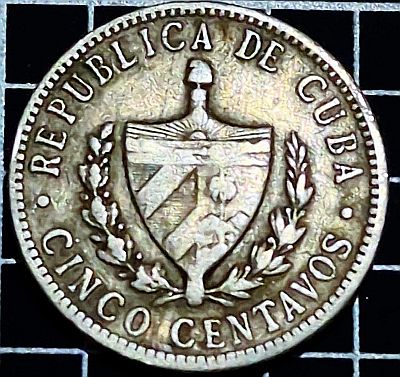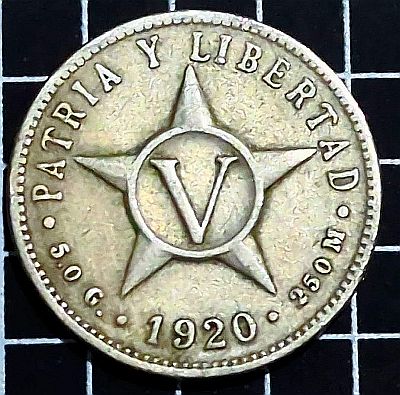An elegant coin from a torn nation
Cuba
Cuba is home to the largest island in the Caribbean, although the nation is composed of over 4,000 islands. Like other islands in the Caribbean, such as the Cayman Islands, and Jamaica, Cuba was first charted by Christopher Columbus, this time on his first voyage in 1492, and settled in 1511. It remained a Spanish possession until 1898. Like Jamaica, the island’s natural exports have historically been plantation agriculture, such as sugar, coffee, and tobacco to Europe and North America, worked primarily by African slaves.
Cuba, green, just below the eastern states of the United States, and to the right of Mexico. Map from Wikipedia.
Proximity to the USA saw the U.S. government attempt to annex or purchase Cuba from Spain throughout the nineteenth century. Rebellion against Spain resulted in the 1868-78 Ten Years’ War. The war ended in a stalemate which planted the seeds of independence in the minds of Cubans. Spain abolished slavery in 1886 (this had been one of the triggers of the ten years war). The War of Independence began in 1895. In 1898, the United States’ largest warship, the USS Maine, was anchored at Havana. It exploded, though whether by accident, or sabotage is a matter for conjecture. Shortly after, the United States joined the war, on the side of the Cuban rebels. Teddy Roosevelt, not yet President, personally financed troops and led them, into victory in the Battle of San Juan Heights on July 1. One hundred years later, in 1998, he was awarded the medal of honour for his actions in Cuba.
Spain surrendered on August 11, and although the treaty officially granted Cuba’s independence, it was the US flag, not the Cuban flag, which flew over Havana. The US refused to allow Cuban generals to take part in the surrender ceremonies. Following the Spanish surrender, the US took control of Cuba, Puerto Rico, the Philippines and Guam.
The American military government in Cuba invited US business interests in to purchase farmland and other properties exceptionally cheaply. Locals were not able to get their crops in shops, and without loans to repair property damaged in the war, had no choice but to sell their land at low prices.
Elections were held in 1900, resoundingly defeating those pushing for annexation by the US. The Cuban flag finally flew over Havana in 1902, after the country’s first president was sworn in. In 1903, a Permanent Treaty gave the U.S. responsibility for “internal tranquillity” and formalized U.S. use of Guantanamo Bay, an issue that remains a sore spot for Cubans to this day.
Although the United States withdrew their military government and handed over to the elected government in 1902, they again occupied Cuba from 1906-9, in 1912, and from 1917-22.
Obverse

The obverse of the coin contains the country name, above the coat-of-arms, with the value below. The text is in Spanish, the official language of Cuba.
The coat-of-arms of Cuba were originally created in 1849, and updated in 1906.
The top section shows the sea with a cape on each side, representing the capes of Sable (Florida) and Catoche (Yucatan), and an ancient key in the centre, representing the closure of the Gulf of Mexico. This symbolizes the strategic importance of Cuba both geographically and politically. In the background, you can see a rising sun spreading its rays along the landscape.
The inferior part is halved, to represent the two areas in which the island was once divided, and shows five stripes of equal width alternating blue and white colors with a positive slope. The other side exhibits a landscape with a palm tree in the centre, with its leaves on the top, representing youth and fertility.
The coat of arms is sustained by a bundle of sticks, tied with a red rope crossed forming an equis, symbolizing the union of all Cubans. The crown of the coat of arms is covered by a red Phrygian cap, with a white star of five points in the centre, turned to the right. On both sides of the coat, you can find a stick of lauren and other of holm oak.
Reverse

Text “Patria y Libertad” (Fatherland and Freedom), with the weight, date and fineness below. In the centre, the value in Roman numeral V (5) in a star. Since 1900 only Cuba and Portugal have regularly used Roman Numerals on coins (Portugal only on the 10 and 20 Centavos of the 1940s to 1960s). The United States used a V on the Nickel from 1883 to 1913. The Mexican state of Durango issued a 5 Centavo coin in 1914 with a V as well. This Cuban coin was first issued in 1915, and minted through until 1961.
Having the weight (5.0 g) and fineness (250M) listed on the coin is not so common today although it used to be more widely used, particularly when coins were “commodity money” rather than “fiat currency“. That is, a 5 centavos coin would contain that value in silver (in this case, a 5-gram coin at 250M, also read as .250 silver or 25% silver, is about 1.25 grams of silver). The M stands for “millesimal“. Today, silver fineness is commonly written as, for instance, .250 or .925, but in either case, it is per thousand, so .250 is 250 / 1000 or a quarter. Higher value coins were made of gold. In this case however, this coin isn’t actually made of silver. It is copper-nickel, with the value representing the composition of nickel.
The Cuban Peso was introduced in 1915, with 1 Peso equal to 100 Centavos. At the time, the coins were:
- 1 Centavo (2.5g 250M copper-nickel)
- 2 Centavos (3.5g 250M copper-nickel – only minted 1915-6)
- 5 Centavos (5g 250M copper-nickel)
- 10 Centavos (2.5g 900M silver)
- 20 Centavos (5g 900M silver)
- 40 Centavos (10g 900M silver)
- 1 Peso (26.7g 900M silver – there was also a low-mintage 1.6g gold version issued in 1915-6)
- 2 Pesos (3.34g 900M gold)
- 4 Pesos (6.68g 900M gold)
- 5 Pesos (8.35g 900M gold)
- 10 Pesos (16.7g 900M gold)
- 20 Pesos (33.4g 900M gold)
The gold coins were all only issued 1915-6. The obverse was consistent on all coins – coat of arms with country name above and value below. The reverse had a star on the copper-nickel and silver coins, with the value in Roman numerals on the star on the copper-nickel coins. Gold coins feature the portrait of José Martí, Cuban National Hero (1853-1895).


Leave a Reply